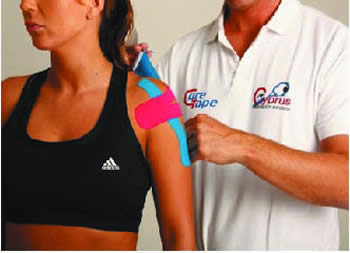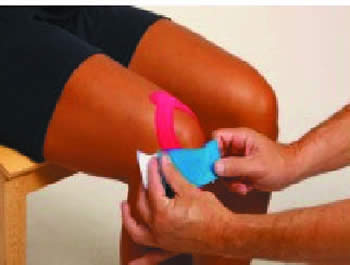Positive Health Online
Your Country

Neuromuscular Taping: Innovative Rehabilitation Technique
listed in physiotherapy, originally published in issue 175 - October 2010
Medical Taping Concept: A Revolutionary Technique
The basis for the Medical Taping Concept (Neuromuscular Taping Concept) was laid in Japan and Korea in the seventies. At the time, methods of taping were being developed, based on the idea that movement and muscle activity are essential in maintaining and in recovering health.
A central concept is that muscles are not only responsible for moving the different body parts, but the muscles also control blood and lymph circulation, as well as body temperature. Improper muscle function can cause a range of symptoms and complaints.
Pursuing this idea several kinds of elastic tape were developed which could support the muscles in their functions without restricting their movement. By treating the 'affected' muscles in this way, the body's own healing process would be activated.
During the development of this method, it soon became apparent that the possible applications were more versatile than for only treating muscle injuries.
One brand of neuromuscular tape that has proven to be useful in this MTC technique is Cure Tape.

Taping Women Athlete

Cure Tape has a similar elasticity and thickness to human skin. The elasticity of the tape in relation to the elasticity of the skin is used to create a lifting effect on the epidermis. Thus, more space is created in the area of the subcutis, where various receptors, blood, and lymph vessels are located. By using different taping techniques several effects can be achieved.
History Of Use In Europe
In 1998, Neuromuscular Taping techniques were launched in Northern Europe and in Southern Europe by the Dutch firm Fysiotape NL and the Portuguese firm Aneid Produtos Farmacêuticos, Lda respectively.
The first Neuromuscular Taping seminar for physiotherapists in Europe was conducted in Portugal by Dr Kenzo Kase in 1998 and was jointly sponsored by Aneid Lda and Fysiotape NL. In the United Kingdom, Aneid UK Ltd introduced the Medical Taping Concept with the launch of CureTape.
Effects and Indications;
The range of applications using the Medical Taping Concept are very wide:
- Follow-up treatment of injuries;
- Reducing inflammations or accumulations of fluid (oedema and haematoma);
- Corrections of posture;
- Treatment of symptoms caused by overuse (such as RSI or tennis and golf elbow);
- Neuro-reflexive manipulation (e.g. when suffering from a migraine, this is one of the treatment possibilities, as is prophylactic taping.)
The Medical Taping Concept is fundamentally different from conventional taping methods, as it stresses 'mobility' and not 'immobilization'.
The possible effects can be listed as follows:
- Improve muscle function by regulating muscle tone;
- Remove congestion in blood circulation and lymphatic drainage;
- Alleviate pain.
Support the joints by:
- Stimulating proprioception;
- Correcting the direction of movement;
- Increasing stability;
- Neuro-reflexive manipulation.
Indications For Medical Taping
- Stimulate hypotonic muscles;
- Influence hypertonic muscles;
- Protect muscles against overexertion;
- Protect joints;
- Neuro-reflexive manipulation.
Scientific Bibliography
As with any innovative method, Neuromuscular Taping, Kinesio Taping or Medical Taping Concept requires a body of clinical cases to provide greater credibility as a new technique. As previously stated, the initial clinical work in Neuromuscular Taping was conducted under the then existing tape - Kinesio Tape during the 1980s in Japan, Korea and Taiwan. From 1998 to 2009, 'western' based clinical trials have been conducted to supplement the work conducted in Japan, Korea and China. The following list of studies provides guidance on clinical work completed to date:
1. Fu TC, Wong AM, Pei YC, Wu KP, Chou SW, Lin YC, Effect of Kinesio Taping on Muscle Strength in Athetes-A Pilot Study. J Sci Med Sport. 11(2): 198-201. Apr 2008.
2. Greve JM. Rossi JD, Cossermelli W, Ferreira Filho AA. Functional Rehabilitation of Degenerative Tendinous Injuries of the Shoulder. Rev Hosp Clin Fac Med Sao Paulo. 46(2):78-81. Mar-Apr 1991.
3. Hsu YH, Chen WY, Lin HC, Wang WT, Shih YF. The Effects of Taping on Scapular Kinematics and Muscle Performance in Baseball Players with Shoulder Impingement Syndrome. J Electromyogr Kinesiol. Jan 13 2009.
4. Jaraczewska E, Long C. Kinesio Taping in Stroke: Improving the Functional use of the Upper Extremity in Hemiplegia. Top Stroke Rehabil. 13(3): 31-42. Summer 2006.
5. Slupik A, Dwornik M, Bialoszewski D, Zych E. Effect of Kinesio Taping on Bioelectrical Activity at Vastus medialis Muscle. Preliminary report. Ortop Traumatol Rehabil. 9(6):644-51. Nov-Dec 2007.
6. Thelen MD, Dauber JA, Stoneman PD. The Clinical Efficacy of Kinesio Tape for Shoulder Pain: A Randomized Double-Blinded Clinical Trial. J Orthop Sports Phys Ther.:38 (7):389-95. Jul 2008.
7. Tsai HJ, Hung HC, Yang JL, Huang CS, Tsauo JY. Could Kinesio Tape Replace the Bandage in Decongestive Lymphatic Therapy for Breast Cancer-Related Lymphedema? A pilot Study. Support Care Cancer. Feb 8 2009.
8. Yasukawa A. Patel P, Sisung C. Pilostudy:Investigating the Effects of Kinesio Taping in an Acute Pediatric Rehabilitation Setting. Am J Occup Ther.60(1):104-10. Jan-Feb 2006.
9. Yoshida A, Kahanov. The Effect of Kinesio Taping on Lower Trunk Range of Motions. Res Sports Med.15(2):103-12. Apr-Jun 2007.
Comments:
-
No Article Comments available